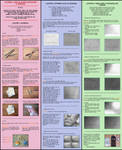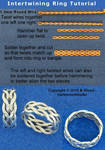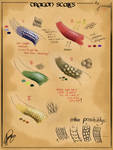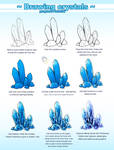The Resource Roundup is a regular feature showcasing some of the best resources deviantART members share with the world!
Whether you're a beginning artist or seasoned pro, deviantART's Resources Gallery is an inspirational and benefitial asset for art creation. Take a look at a few of the incredible submissions below – they might help enhance your next artistic creation!
This issue is all about tutorials. What should the next Resource Roundup theme be? You tell us!
• Photography: beginners to advanced
• Crafts you can make at home
• Marketing yourself: website, logos, and business cards…oh my!
• Awesome application resources (from Photoshop brushes to Gimp scripts)
• Or, suggest another topic!
Drawing


Artisan Crafts



Writing
Plots and Plot Twists.
What is a plot? A plot is a series of sequential events that make up your story. Sure, anyone could have told you that. But, how to write one? How can you make something this simple extraordinary?
Plot is comprised of 3 different parts; beginning, middle and end. Think of it this way…this is how the problem started, this is how we fix it, and this is how we fixed it. Make sense? As long as you stick to this simple outline, it will be much easier for you to create your plot. Plots are also comprised of other parts; the exposition, rising action, climax, falling action, and resolution.
The Exposition: This is the very beginning of your story in which your characters and some important themes are laid out. Describe the setting; time era, place and who the characters are. Describe to the audience just WH
Tips For Editing Poetry
***Tips For the Novice (and otherwise) - Editing***
The blanket statement, "Editing/revision harms poetry," is simply wrong. It's akin to a photographer claiming that focusing the lens ruins the emotion of the photograph. It is the details, and the appropriate attention paid to them, that separate a photograph from a snapshot. Imagine a film maker slapping every frame he shot up on the screen without editing for continuity, for pacing, for effect. What a disaster. That is not to say that editing can't be destructive - there is such a thing as poor editing, just as there is poor writing. But done correctly, done well, it is one of the most important tools in the poet's shed.
Never shy away from editing/revision. Some young writers feel that to revise is to kill the spirit of the poem. This notion serves to sacrifice the potential of a poem for an ideal that
A Guide to Writing StyleWriting Style - The Bottom Line:thumb105806015::thumb175344435:
“Words are like sunbeams. The more they are condensed, the deeper they burn.” - Robert Southey
“Prose is architecture, not interior decorating.” - Ernest Hemingway
Writing style is made up of two things: cadence and variation.
Good style is clear, readable, and invisible. Its purpose is not to attract attention to itself but to transport readers into the world of your story. If your readers notice your style without purposefully intending to study it, your style needs to be improved and refined. Good style, however, is transparent so that your readers simply see the characters and world of your story rather than the words you use to portray them.
To write with cadence simply means that your writing should sound natural. If it sounds right to you, it probably is--but if it doesn’t sound right,
Tips to Creative Writing
1. Know what you're writing.
It's easy to get off track while you're writing. Thus it's always a good idea to know what you're writing. As soon as you have a good grasp on what your story is about, you'll find yourself writing quicker. This includes the main plot, a majority of the subplots, and where all the vital plot points are going to be.
2. Know what inspires you and stay around it.
Now this doesn't mean that you should go through an entire personal evaluation. It just means to keep track of where you get inspired and what caused the inspiration. For some, it could be listening to music of some sort, while for others, it could be watching families at the park. Whatever it is, try to be around it whenever you can.
3. Map out your story.
Now this is something that a lot of people take out of hand. When mapping out your story, you don't want to have everything in a certain slot. Things can't be one hundred percent organized. The story could change in a way that
A Short Guide to BrainstormingGot nothing to write? Stuck in the middle of a story? Just getting your mind wrapped around a new idea? Asking yourself, "Where do I go from here?"
Here is the two-step guide to story development. It works every time, 100% guaranteed.
Step one:
Ask yourself this simple question: "What if?"
Staring at a blank page? Ask "What if . . . ?"
Stuck in the middle of a story? Ask "What if . . . ?"
Don't know how to end your story? Ask "What if . . . ?"
Don't think your story is going in quite the right direction? Ask "What if . . .?"
Step two:
Ask yourself this second simple question: "Why?"
What if aliens invaded our planet?
Why?
What if the antagonist is obsessed with redheaded women?
Why?
What if the good guy dies in the end?
Why?
What if the protagonist lies to his love interest instead of telling her the thing he desperately wants to get out?
Why?
Here's the point:
Absolutely anything is possible in the world o
Painting
 :thumb102447192:
:thumb102447192:

Digital







Anatomy


Mature Content


 :thumb250651485:
:thumb250651485:


